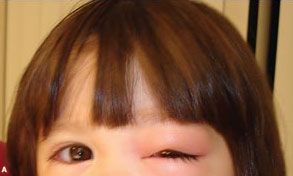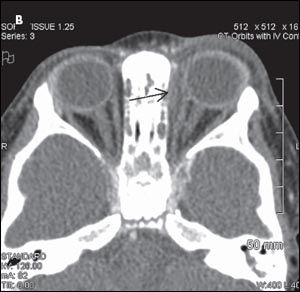Orbital Cellulitis
This 14-month-old girl was brought for evaluation of marked swelling and erythema of the left eyelids (A) The mother had noticed a green discharge and mild swelling of the eye 2 nights earlier.

This 14-month-old girl was brought for evaluation of marked swelling and erythema of the left eyelids (A). The mother had noticed a green discharge and mild swelling of the eye 2 nights earlier. The swelling had progressed and now completely obscured the eyeball. For the past week, the child had greenish rhinorrhea and cough. She had been afebrile and was eating well without emesis. She had no history of facial trauma or insect bite. Her father and sibling currently had infections of the upper respiratory tract and eye.
Examination revealed erythema and eyelid edema and pain around the left eye. No conjunctival injection or proptosis was noted. Extraocular muscles were intact. Nasal turbinates were swollen, and there was clear rhinorrhea. Tympanic membranes and throat findings were normal.
The child has orbital cellulitis. This cellulitis involves the soft tissue posterior to the orbital septum and is the least common cause of “swollen eye.”1 Its distinguishing features include hyperemia of the skin, edema of the eyelids, conjunctival edema, orbital pain, proptosis (with the globe usually displaced anteriorly and downward), and limitation of ocular movements (especially upward gaze).1
Orbital cellulitis may follow trauma or surgery or may be secondary to the spread of sinusitis-the suspected cause in this patient. Diabetes and immunosuppression are important risk factors. Causative organisms include Staphylococcus aureus, Streptococcus pneumoniae, Streptococcus pyogenes, Haemophilus influenzae, Moraxella catarrhalis, and anaerobes of the upper respiratory tract.1 Methicillin-resistant S aureus (MRSA) is responsible for an increasing number of intraocular infections2 and warrants particular attention when choosing antibiotic therapy because of its increased potential for tissue invasion. Orbital cellulitis caused by MRSA can lead to irreversible blindness when left untreated.3
When orbital cellulitis is suspected, a CT scan of the orbits with contrast must be obtained to rule out subperiosteal abscess. This is the most common complication, and it can increase the likelihood of vision loss via direct optic nerve pressure.4 In this case, an orbital CT scan revealed inflammation; no fluid was present to suggest an abscess (B).

Antimicrobial regimens for orbital cellulitis include ampicillin/sulbactam or cefuroxime, with addition of metronidazole or clindamycin when anaerobes are suspected. 1 Prompt operative drainage is warranted in patients with no clinical improvement after 48 to 72 hours of therapy, worsening symptoms after initial improvement, or an abscess.
Preseptal, or periorbital, cellulitis involves the soft tissue anterior to the orbital septum. This cellulitis is characterized by swelling of the eyelids.1 It may be caused by direct spread of localized infection-conjunctivitis, hordeolum, dacryoadenitis, and dacryocystitis-or by hematogenous spread of nasopharyngeal pathogens. Infants and toddlers are especially prone to periorbital cellulitis caused by dacryocystitis.5 Rarely, preseptal cellulitis is secondary to infected sites of trauma (eg, insect bites) and impetigo.1 Bacteremic preseptal cellulitis often occurs in children younger than 18 months and can be distinguished from other causes by its rapid progression and the presence of a high fever. Preseptal cellulitis that presents as a complication of paranasal sinusitis commonly occurs in children older than 2 years who have had a viral upper respiratory tract infection for several days. These children usually have an unremarkable white blood cell count and negative blood cultures.1
Treatment includes drainage of suppurative material for Gram stain and culture and intravenous antibiotics. Nafcillin (for posttraumatic causes) or cefuroxime (for other infectious causes) is used initially unless results of Gram stain and culture suggest otherwise.1
References:
REFERENCES:
1. Wald ER. Periorbital and orbital infections.
Infect Dis Clin North Am
. 2007;21:393-408, vi.
2. Freidlin J, Acharya N, Lietman TM, et al. Spectrum of eye disease caused bymethicillin-resistant Staphylococcus aureus.
Am J Ophthalmol
. 2007;144:313-315.
3. Rutar T, Zwick OM, Cockerham KP, Horton JC. Bilateral blindness fromorbital cellulitis caused by community-acquired methicillin-resistant Staphylococcusaureus.
Am J Ophthalmol.
2005;140:740-742.
4. Jones DB, Steinkuller PG. Strategies for the initial management of acute preseptaland orbital cellulitis.
Trans Am Ophthalmol Soc
. 1988;86:94-108; discussion108-112.
5. ZaldÃvar RA, Buerger DE, Buerger DG, Woog JJ. Office evaluation of lacrimaland orbital disease.
Otolaryngol Clin North Am
. 2006;39:911-922, vi.